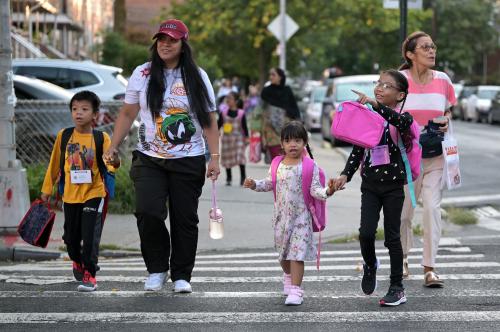THE SITUATION
Too many children in the United States do not have access to affordable, high-quality early childhood care and education (ECE) during their first five years of life. Very good ECE programs can yield large and long-lasting benefits both to individuals and to society. Over the past two decades, strong public support for ECE, increased state investments in preschools, and federal efforts to improve access to high-quality programs have contributed to meaningful improvements in access to affordable early childhood programs, especially for four-year-olds.
Still, many parents of young children cannot find or afford programs that both support their children’s development and meet their needs for reliable child care. The average cost of full-time, center-based care is just under $1,000 a month, and families’ expenditures on child care often exceed that spent on food, rent, or higher education. Public programs meant to assist families find and afford high-quality ECE are disconnected from one another, leaving families to navigate between complex bureaucratic systems. Families who do find a spot are often in mediocre programs that are unlikely to yield meaningful benefits.
The lack of a cohesive system of high-quality, affordable ECE therefore represents a missed opportunity to provide a strong foundation for later learning.
Public investment in early childhood
The federal government currently supports families and children through a host of ECE programs as well as tax provisions that subsidize the cost of child care. These programs are administered by multiple agencies, target different populations, and have different goals. While some programs are child-centered and focus on providing high-quality learning opportunities, others are intended to serve as work supports for parents.
Families with working parents receive some support through the federal Child and Dependent Care Tax Credit and the Dependent Care Flexible Spending Accounts. Low-income families typically do not benefit from these tax credits. They may, however, be eligible for the federal Head Start and Early Head Start programs, which directly offer early childhood educational programming to low-income children. And they may also be eligible for subsidized care through the federal Child Care and Development Fund (CCDF), which provides states with block grant funding to subsidize child care for low-income parents who are employed or attending school. Currently the fund provides over $5 billion dollars to state subsidy programs, and states match and supplement using their own funds.
Notably, neither child-care subsidies nor Head Start are entitlements; not all eligible children are served. One recent analysis suggests that less than one-third of federally eligible children under six years old receive subsidies, approximately 42 percent of eligible three- and four-year-olds attend Head Start, and less than 4 percent of eligible children are served by Early Head Start. Some additional children are served through state or local ECE programs, which have expanded over time. Since the early 2000s, enrollment in state-funded pre-kindergarten programs has doubled. Today, public pre-kindergarten programs in 42 states and DC serve about 29 percent of four-year-olds nationwide. Still, families—and particularly those with infants and toddlers—struggle to find high-quality, or even safe, child care for their children.
A number of recent federal initiatives have sought to improve access to high-quality ECE and to facilitate coordination across agencies. The Improving Head Start Act of 2007, for example, mandated that all states create Early Childhood Advisory Councils to help develop coordinated systems of early childhood education and care. The federal Race to the Top – Early Learning Challenge (RTT-ELC) competitively allocated roughly one billion dollars to 20 states since 2011 to improve quality and access in early childhood through coordination across child-care and preschool initiatives. In 2014, the Obama administration set aside $635 million for Early Head Start-Child Care Partnerships to help private centers and family child care providers give higher-quality, comprehensive services to low-income children. And the Every Student Succeeds Act of 2015 authorizes new, competitively allocated Preschool Development Grants specifically aimed at providing coordination across early childhood sectors.
These efforts have signaled an encouraging federal commitment towards systems building, improved access, and a focus on quality. However, even with these heightened investments at the state and federal levels over the past decades, the United States continues to make a much smaller public investment in ECE than peer nations. In 2011, the United States invested less than 0.5 percent of the GDP on child care and early childhood education programs. Only three OECD nations spent less, while eleven of them—including France, the United Kingdom, Denmark, Israel, and Korea—spent at least twice as much. Without a major increase in our public investment in early childhood, high-quality affordable programs will remain out of reach for many American families.
Challenges in the current system
The cost of child care—particularly care for infants and toddlers—is too high for many low-income and middle class families. In 2015, full-time care for preschool-age children ranged from $12,781 per year for center-based care in Massachusetts to $3,675 for family day care in Mississippi. The rates are even higher for programs that serve infants and toddlers who require more individualized attention.
CCDF provides states with considerable discretion in terms of both subsidy eligibility and generosity. Unfortunately, state subsidy generosity has decreased over time, both with respect to eligibility income cutoffs and subsidy size. In 2015 only one state had reimbursement rates at or above 75 percent of the market child-care rate, and the average subsidy for center-based child care was only $4,900, considerably less than the average cost of care. Low reimbursement rates force families to trade off paying out of pocket or choosing a lower-cost option—a trade-off that reduces the chances low-income children will enroll in high-quality programs.
The 2014 CCDF reauthorization introduced changes that are intended to improve the stability of subsidy receipt and improve quality of care. However, these provisions have not been accompanied by a significant increase in federal investment, raising concerns that states will meet the requirements by serving fewer children.
The early childhood workforce is characterized by very low levels of education and pay, and high turnover. Just as they are in K-12, great teachers are essential for providing children with experiences that truly support their development. To date, however, too few discussions about providing high-quality early childhood programs have explicitly stated that improving quality in early childhood requires a major investment in supporting the early childhood workforce. The economic penalty for teaching young children—even relative to teaching elementary school students—is steep. Nationally, kindergarten teachers make an average of $53,000 per year, state-sponsored pre-K teachers with a bachelor’s degree make $43,000, Head Start teachers make $33,000, and other ECE teachers make $29,000. Early childhood teachers with bachelor’s degrees have the lowest lifetime earnings of any college major.
Our current system offers few incentives for workers to stay in the field or to invest in their professional development. Turnover among child-care workers is four times higher than for elementary teachers.
Further, many early care workers lack the knowledge and training needed to effectively support young children’s learning. Even when ECE teachers do invest in their professional development, the courses and trainings they receive often do not focus on the skills and competencies needed to support children’s early learning, and hardly benefit young children.
The early childhood care and education landscape is fragmented and includes programs with starkly different quality regulations, funding streams, and goals. Head Start and pre-kindergarten programs face much stricter quality guidelines than do licensed centers. For example, while Head Start and nearly all pre-kindergarten programs require teachers to complete some pre-service coursework, less than a third of states’ child-care regulations require the same preparation. In part, these differences reflect historical differences in mission. Subsidized child care has primarily served as a work support for low-income families. In contrast, programs like Early Head Start and Head Start are explicitly focused on improving children’s developmental outcomes.
These long-standing distinctions make no sense. Families need programs that simultaneously provide a reliable work support and an engaging learning environment. Further, given the unique importance of children’s earliest years, we cannot be satisfied when the quality of care options available to infants and toddlers is far lower than the quality of programs available to preschoolers.
RECOMMENDATIONS
Overhauling ECE will require a major economic investment. The next president must lead the way by (1) ensuring low-income and middle class families are not forced to make decisions between high-quality and affordable care, (2) supporting efforts to transform the early childhood workforce, and (3) building cohesion within a highly fragmented system.
- Substantially increase child-care subsidy spending. Direct states to spend the increased funds on both increasing the income eligibility up to 200 percent of the poverty rate and increasing the reimbursement rates so that they are at least 75 percent of the prevailing market rate.
These efforts will not only enable more low-income families to access quality child care, but will also provide programs with the resources needed to support the provision of higher-quality care. To be sure, meeting this requirement requires a major increase in public spending on child care. While it is difficult to precisely estimate the cost of such a change, we estimate it would require more than a doubling of current levels of state and federal expenditures (now approximately $7.2 billion).[1]
Why expand child-care subsidies rather than expanding the child-care tax credits? Tax credits are not given to families who do not owe taxes, and many of the lowest-income families are ineligible. Even those families who are eligible for tax credits may not be selecting the higher-quality programs the tax credits are meant to facilitate. The funding model for much of the child-care market requires advanced payments and significant upfront deposits. Families seeking care must have the ability to pay up front. When care is expensive, the sticker price may dissuade them from choosing a high-quality child-care option, even if they can recoup the cost later in the year.
Why expand child-care subsidies rather than increase funding for Head Start or support state pre-kindergarten efforts? Children who enroll in state pre-K and Head Start begin kindergarten substantially more ready to learn than children who did not have access to these programs. States’ efforts to serve more three- and four-year-old children through pre-kindergarten programs and to improve the quality of these programs are encouraging. In the context of expanding state and local prekindergarten programs, it is important to recognize that most early education programs need to be supplemented with child-care funding in order to meet the needs of low-income working parents. Moreover, given the focus of these programs on children in their year before kindergarten, working parents of younger children face greater obstacles to accessing quality care, especially center-based care, than parents of older children.
Through a substantial expansion in child-care funding, as well as through expansions of the center-based Early Head Start program, the federal government can help build an ECE system where the educational needs of the youngest children (0-3) and preschool age children are met while also meeting the care needs of low-income working parents. The first priority should be supporting low-income families and doing so through existing state systems, which should be made more comparable and more generous across all states. Second-order priorities should be further expanding the number of children who enroll in Head Start as three- or four-year-olds and providing a more generous refundable tax credit to all families with incomes under 400 percent of the poverty line.
- Improve program quality by supporting efforts to professionalize the early childhood workforce.
Currently, too many early educators struggle to earn a living wage. It is unrealistic to expect quality to improve in early childhood settings without increasing compensation in order to attract and retain skilled caregivers. At the same time, low-income families cannot, on their own, carry the cost of making this happen in a private market. For this reason, significant public investment is needed.
Some local governments, including cities like New York, Boston, and Seattle, have made a commitment to gradually eliminating the pay gap between K-12 and public pre-K teachers. At the federal level, the increased spending on subsidies, described above, may help address this issue, particularly in the programs serving the youngest children, as would additional Head Start funding targeted to teacher salary. Offering states matching funds for salary increases, increasing tuition assistance and loan forgiveness for early childhood teachers, and helping to develop competency-based career ladders would help, too.
But pay isn’t enough. Changing core teaching and learning processes—the daily lived experiences of young children in a classroom—requires not just better-paid teachers but also better-trained teachers. This requires reforms in how teachers are trained before they enter an early childhood classroom and how they are supported once they do.
As with K-12 schools, we have only limited evidence on how to effectively train pre-service ECE teachers. However, the way early childhood teachers are trained now—in general child development and practices, without adequate attention to specific developmental trajectories and specific instructional strategies, and with wide variation in training across states—matches neither the evidence we do have nor common sense.
We concur with recommendations from the National Institute of Medicine and National Research Council, which include that training for all teachers of children 0-8, irrespective of sector, emphasize specific core competencies including both training in child development within specific developmental domains (e.g., language, literacy, mathematics, and socio-emotional skills) as well as training in instructional strategies that support development in those domains. Once teachers are in the classroom, the most promising routes to improving the low-quality instruction that is common in most early childhood programs is pairing regular coaching with a proven, evidence-based curriculum.
Given the state of the teacher training research and the complexity and diversity of the 0-5 workforce, there is not one right answer to quality improvement. However, we do have enough evidence that all federal efforts around quality improvements in early childhood settings should be more narrowly defined to focus on improving the quality of learning opportunities children receive by specifically focusing on their teachers. This means supporting increased compensation initiatives but also ensuring that federal investments in programs are targeted towards practices that are directly connected to improved child outcomes.
As one example, the federal government can provide states with more direction on how the Child Care and Development Block Grant (CCDBG) funding set aside for quality improvement can be used. Currently the list of activities that can be funded is quite broad; any activity that promotes professional development, regardless of the content of the training, can count toward the quality set-aside. Funds should be limited to more narrowly defined activities that support the early childhood workforce and are directly connected to proven classroom practices. In addition, current federal financial aid and loan forgiveness programs for teachers could be revised to encourage teachers to train in programs that follow the recommendations of the National Institute of Medicine and National Research Council. The federal government could also support innovative partnerships with both two- and four-year colleges and universities and preschool systems. We need an era of systematic, creative experimentation in ECE teaching training accompanied by increased compensation.
- Proactively encourage novel approaches to systems building.
The federal government should make reducing fragmentation a key goal for all federal investments in early childhood. A recent GAO report concluded that the current system, in which multiple federal agencies are administering early childhood programs, is leading to both duplication and gaps in service provision. That report called for an interagency workgroup involving all federal agencies with programs serving young children as a strategy towards reducing fragmentation and service duplication. While that may help, the best way to reduce fragmentation may be to reduce the large differences across programs in structure, funding streams, eligibility requirements, and quality regulations.
A cohesive early childhood system must align ECE with the K-12 system and align programs that serve infants and toddlers with those that serve preschoolers. Doing this requires breaking down longstanding, but false, distinctions between subsidized child care and more child-centered, developmentally oriented programs like Early Head Start and Head Start.
We suggest the federal government give selected states the flexibility to experiment with novel approaches to this complex systems building. We propose a competitive granting process through which states that have shown a longstanding commitment to ECE and systems building could propose initiatives that allow them to pull resources from diverse local, state, and federal early childhood programs towards building a more practical, streamlined, and high-quality early childhood landscape. To be eligible, state proposals would need to include active participation from all the key players—Head Start, state or local pre-kindergarten programs, and child-care providers. Proposals for coordinated systems would be required to maintain (at least) the same level of state spending and the same percentage of children served. The federal government should provide careful oversight to ensure quality is not compromised in these structured flexibility experiments. Critically, the federal government must embed a requirement for rigorous research into the selection process so that lessons from these flexibility experiments could inform efforts nationwide.
CONCLUSION
Early childhood investments have the potential to yield great returns. In this unique moment with widespread public support for early childhood, the president has the opportunity to “go big” on early childhood, not just tinkering on the edges but leading a transformation. Doing so will ensure that all families with young children can find and afford programs that not only allow the parents to work but give the children—including infants and toddlers—opportunities to explore, engage, and learn.
[1] Evidence suggests that about 30 percent of state income eligible children are receiving subsidies. About 38 percent are not receiving any public assistance subsidies. If a little more than half of these children enter the subsidy system (20 percent of eligible children), that would increase expenditures by about two-thirds. Based on current market rate information, a rough approximation suggests that on average reimbursement rates are about 20 percentage points lower than the 75th percentile of the market rate, suggesting it would cost 25-percent increase to raise rates to the 75th percentile of the market rate. Finally, a rough approximation suggests that states on average set income eligibility at 160 percent of the federal poverty threshold, so a 40-percentage-point increase (20-percent increase in funding) would be needed to cover families up to 200 percent of the federal poverty threshold.
Support for this project was generously provided by the Spencer Foundation. Brookings recognizes that the value it provides is in its absolute commitment to quality, independence, and impact. Activities supported by its donors and by outside contributors reflect this commitment. The authors did not report receipt of financial support from any firm or person for this memorandum or from any firm or person with a financial or political interest in this article that creates a conflict of interest.
Suggested citation:
Bassok, D., Magnuson, K., & Weiland, C. (2016). Building a cohesive, high-quality early childhood system. In M. Hansen & J. Valant (Eds.), Memos to the President on the Future of U.S. Education Policy. Washington, DC: Brookings Institution.






Commentary
Memo: Building a cohesive, high-quality early childhood system
December 19, 2016